Visit the art blog at thematicconversion.tumblr.com and the relog blog at evtrained.tumblr.com.
92 posts
02 Of 05 - Modern Compendium; Kishin Family, Part 3 - Genma Molly Pitcher
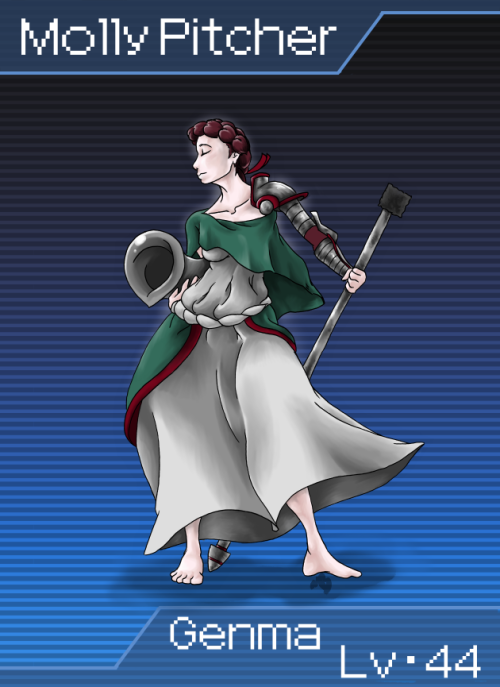
02 of 05 - Modern Compendium; Kishin Family, Part 3 - Genma Molly Pitcher
Say hello to our very first demon from the Genma family! In most Shin Megami Tensei games, the Genma family is home to demigods and half-human demons. The partially human aspect of this family is really fascinating, so I’ve given this part of the Modern Compendium over to figures from modern American folklore, which is unique in that it consists almost entirely of figures with superhuman powers, yet without an explicit connection to a god or gods.
Molly Pitcher is a particularly popular figure in American folklore. Supposedly, she was one of many women who followed their husbands off to war in the American Revolution. She worked on the battlefield tending the wounded and bringing water to the soldiers (hence Molly Pitcher), but when her husband fell in battle, she picked up his weapons and fought in his place.
Popular history says that Molly Pitcher was in fact an actual woman named Mary Ludwig Hays McCauley, who fought in the Battle of Monmouth in 1778. However, there are a huge number of stories that fit the general profile of Molly Pitcher tales, and the deeds of the woman in question have grown to superhuman proportions with retellings. This makes it likely that any stories you hear about Molly Pitcher are actually composites, built from the deeds of dozens of women, not just one.
Thanks to the enduring popularity of her story, Molly sits pretty snugly in the middle of the Genma family. Like most Genma, she’s primarily a physically offensive demon, but she does have some limited healing magic to throw around, too. All in all, she’s a very solid demon for the mid-game.
For more info on this and every other demon in the Modern Compendium, have a look at our extensive and ever-growing Data File, right over (here)!
(Incidentally I just wanted to mention that I briefly thought about designing Molly Pitcher to look like the Kool-Aid Man, as a reference to that goofy April Fool’s Day joke from a while back. But someone beat me to it. [link])
-
 kinemax liked this · 8 years ago
kinemax liked this · 8 years ago -
 abstractscarecrow reblogged this · 9 years ago
abstractscarecrow reblogged this · 9 years ago -
 koshercarcosan reblogged this · 10 years ago
koshercarcosan reblogged this · 10 years ago -
 abstractscarecrow reblogged this · 10 years ago
abstractscarecrow reblogged this · 10 years ago -
 abstractscarecrow liked this · 10 years ago
abstractscarecrow liked this · 10 years ago -
 historyclasses reblogged this · 10 years ago
historyclasses reblogged this · 10 years ago -
 xerozohar liked this · 10 years ago
xerozohar liked this · 10 years ago -
 vodka-drawsinski liked this · 10 years ago
vodka-drawsinski liked this · 10 years ago
More Posts from Historyclasses
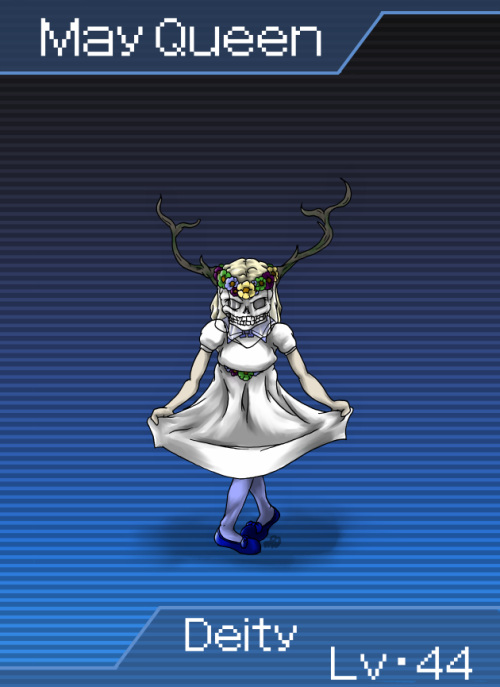
01 of 05 - Modern Compendium: Deity Family, Part 3 - Deity May Queen
The May Queen is a demon that shows the difference between what the basis of a myth actually is, and what people think it is. In modern times, the May Queen is a young woman elected to preside over May Day celebrations, to walk at the head of the parade and open the holiday dances. Historically, the May Queen is related to ancient tree worship, as this figure is closely connected with Maypoles, and the celebration of the return of spring. She wears a white dress to symbolize purity, and flowers in her hair to celebrate the renewal and rebirth of nature.
However, the May Queen is a myth whose historical fact has been largely overtaken by popular folklore. There is a popular and persistant urban legend that, somewhere in the murky depths of time, the May Queen was actually a sacrifice in waiting. Supposedly the people of English villages would select a young woman, give her all the best that they had to offer, and then, after May Day had passed, sacrifice her to some vicious pagan god. No doubt bloody stone altars and obsidian knives were involved.
However, and this is important to note, there is no evidence that I can find to actually back up the idea that this was ever done. As far as I can tell, someone somewhere just thought it sounded like a neat thing to tack on to the May Queen, and it stuck. Equally important is the fact that this gory and disturbing footnote to May Day is in fact very widely believed. No doubt the horror film The Wicker Man and its atrocious-bordering-on-comical 2006 remake are at least partially to blame, but whatever the cause, society at large has no trouble imagining a vicious start to this May Day tradition.
In any case, it is unfortunate for the May Queen that the version of any myth that matters for any practical purpose is the one that people actually believe in. And so the May Queen that gets into the Modern Compendium is the one with the disturbing backstory. The May Queen actually sits on the lower end of the Deity family, due in part to the dubious nature of belief in this version of her, but also because May Day celebrations aren’t hugely widespread outside of Europe and select parts of North America.
For more info on this and every other demon in the Modern Compendium, have a look at our Data File, right over (here).
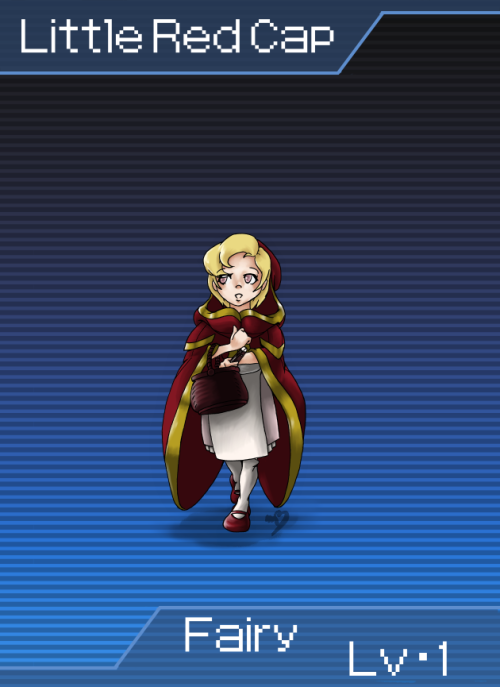
01 of 05 - Modern Compendium - Fairy Little Red Cap
This WAS going to be just a reblog to show I updated Little Red Cap’s artwork, but Tumblr doesn’t let you edit your stuff that way anymore. But that’s okay, I’m not really happy with how the old post reads anyway. So let’s do the whole thing over again! 8D
Anyway, Little Red Cap, better known as Red Riding Hood, is a perennially popular figure from fairy stories. The basic story is of course well known; a young girl is sent off to bring food to her ailing grandmother, but she has to go through the woods to get to grandma’s house. Along the way, a wolf stalks her, learns where she’s going, and gets to the house first, where she eats the girl’s grandmother. Little Red Riding Hood arrives at the house and engages in a battle of wits with the wolf, with the girl suspicious of her grandmother’s new appearance. There are a lot of variations on the ending, but usually the girl and her grandmother escape unscathed.
The popularity and extremely long history of Red Riding Hood’s story means there is a huge number of variations on the story. Sometimes the grandmother is eaten, sometimes she’s just imprisoned. Sometimes Red Riding Hood is saved by a woodcutter, and sometimes she outsmarts the beast. Heck, sometimes the wolf is a werewolf and LRRH actually has no cape on. Some scholars believe the story has origins as far back as the 10th century AD, so there may be as much as a thousand years worth of variation to work with here.
There is one major defining thing about the story that never changes. The underlying message of Little Red Riding Hood’s story is that there is a clear delineation between HERE, which is safe, and the scary, dangerous, wolf-infested THERE, and that wandering into it is not a good idea. I feel like that’s a good way to start a Shin Megami Tensei story - by announcing that you’ve just wandered into a very dangerous place that you should not be.
See, Little Red Cap is the Modern Compendium’s Pixie. She’s the first demon you meet, and she’s more or less your introduction to how demon allies work. She’s also capable of mass destruction should you level her high enough, learning Megidolaon at Lv. 65, which is actually a lower level than most other demons who get the skill. I admit this is equal parts a reference to the high-powered late game Pixie of Nocturne and my own love of cute things that are secretly capable of mass destruction.
For more info on this and every other demon in the Modern Compendium, have a look at our Data File, right over (here).
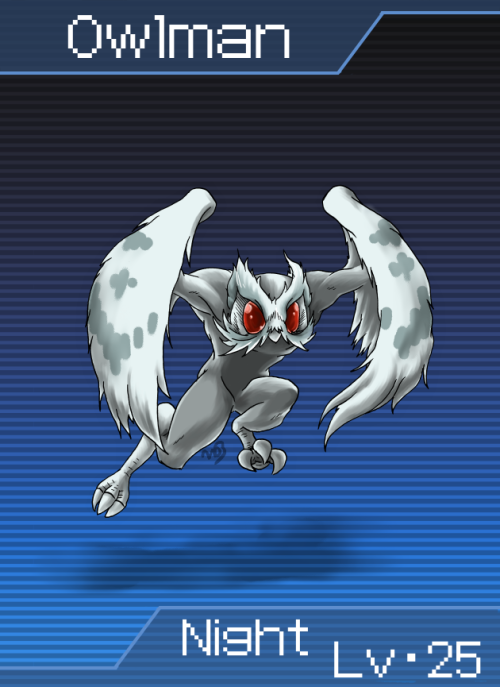
05 of 05 - Modern Compendium: Kishin Family, Part 4 - Night Owlman
First off, a bit of a confession; when I scheduled Owlman for this ALL AMERICAN FIREWORK DEMONFEST, I, uh, thought Owlman had been reported in the United States. I figured hey, we already did Thunderbird, we need an avian to stand in for the Bald Eagle, let’s do Owlman. Imagine my shock when I went back to my research and realized he’s an English critter. Whoops. ^^;
Oh well. Press ahead anyway! Owlman is a Cryptid first sighted in Cornwall, specifically in the village of Mawnan. The first reports painted a picture of a winged man with huge glowing eyes and clawed feet, hovering above the church steeple. Since then, there have been multiple sightings of the beast, all following along similar lines.
Many different solutions to the mystery of the Owlman have been suggested. Some say that the village church lies on a major leyline, and that the Owlman may be an embodiment of the spirit of the land, wreaking vengeance on humankind. Others point out that there are in fact colonies of Eagle Owls nearby, which have a wingspan of something like six feet and whose eyes are enormous and reflect light quite well in the dark. Or, given that the first person to seriously write about the Owlman was a well-known hoaxer named Tony Shiels, it’s entirely possible that the whole thing is just a joke that got out of hand.
At any rate, many people have compared the Owlman to North America’s Mothman, a fact which has always confused me. The Mothman is widely regarded as a sort of latter-day Banshee, bringing warning of disaster along with its menacing fly-bys, but the Owlman has never been seen to do anything but chase folks around and screech a fair bit.
Because of the general shakiness of its base of belief, and because it’s not generally considered actually dangerous or powerful at all, the Owlman sits very low in the Night family. Right at the bottom, as a matter of fact.
For more info on this and every other demon in the Modern Compendium, have a look at our Data File, right over (here).
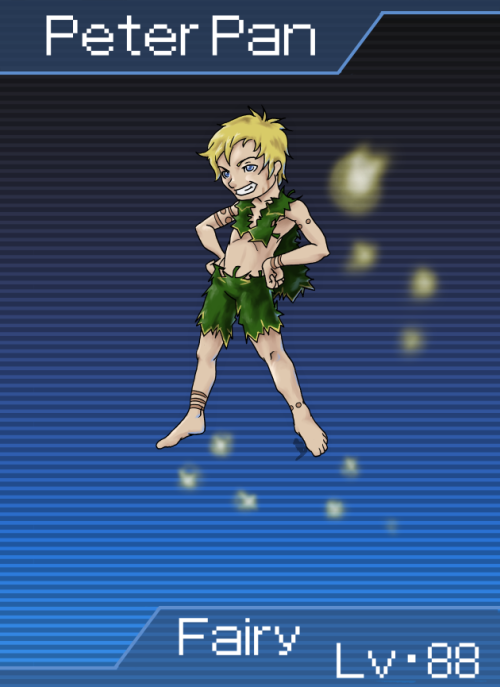
03 of 05 - Modern Compendium: Deity Family, Part 2 - Fairy Peter Pan
Though most people today know this fey youth through the popular Disney film, Peter Pan actually started out life as the brainchild of a Scottish novelist named J. M. Barrie. Barrie based Peter in large part on his older brother, who died at a very young age, but large parts of the character were also influenced by traditional fairy stories. In particular, Peter was supposed to have “left” his parents as a baby, only to come back later and find another child in his place, an element that strongly resembles the stories about Changelings, creatures of fae origin left in place of human children. And of course the idea of an eternally young human raised by fairies is a fairly common motif in fairy stories.
Like Jack Frost, Peter Pan has experienced a significant increase in popularity thanks to his inclusion in the canon of popular culture. These days, most people see Peter as a slightly mischievous, but usually heroic figure. However, his initial characterization was a bit more complex. Written as an exaggerated stereotype of a boastful and arrogant child, the original Peter Pan more or less personifies the arrogance of youth. One way this surfaces is in the way Peter retains his immortality, sacrificing his memories and experiences in order to remain young.
Peter was a pretty challenging demon to design, thanks to the great influence Disney has had in molding ideas about him. It was difficult to come up with a design that would include that source as an influence, but still look like it fit in a Shin Megami Tensei universe. In the end, I tried to go for a design that emphasized Peter’s feral arrogance, but still retained some whimsy and humanity.
Peter’s near ubiquity in the cultural lives of children means he’s a very robust figure in the Fairy family, coming in right at the top. He gets some very strong skills, but thanks to the Fairy family’s low power overall, he’s not overwhelming. I like to think Peter would be one of your first real end-game demons.
For more info on this and every other demon in the Modern Compendium, have a look at our Data File, right over (here)!
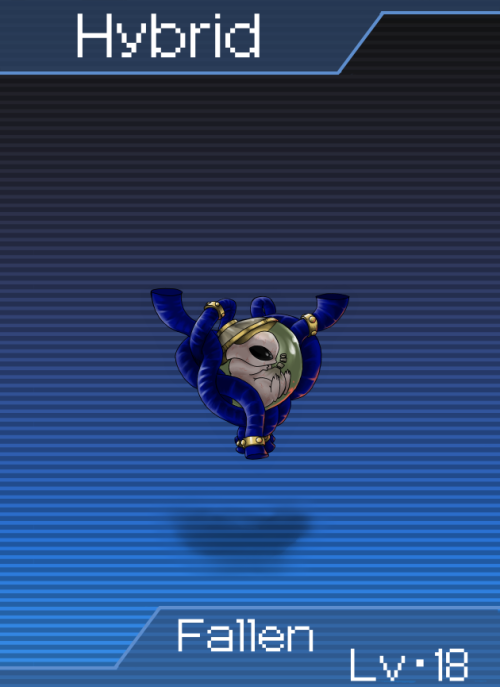
02 of 05 - Modern Compendium: Deity Family, Part 3 - Fallen Hybrid
Say hello to the first member of the Modern Compendium’s Fallen family! In Shin Megami Tensei games, the Fallen family is populated by angels that sided with Lucifer during his rebellion against and subsequent fall from Heaven. They are sort of the Chaos aligned equivalent of the Divine family, which is full of loyal, Law-based angels. In the Modern Compendium, the Divines are benevolent aliens from the mythology of UFO religions, and so the Fallen family shifts, too, becoming a family full of antagonistic aliens.
The stories around UFOs and aliens represent one of the richest veins of mythology in the modern mind, and one of the more popular tales people tell has to do with the Grey aliens. Often blamed for alien abductions, the Greys are said to perform elaborate and invasive procedures on the reproductive systems of the people they kidnap. These stories have led to theories that Greys are trying to create a race of Grey/Human hybrids, to infiltrate our culture and take over the world.
In fact, the actual purpose of this hybridization varies hugely depending on who is telling the story. Though many conspiracy theorists believe in the whole Greys-are-invading-our-genome-to-enslave-us idea, those who believe in more benevolent aliens tell stories of children with enhanced powers of empathy and kindness. This is best exemplified in this demon’s direct mirror in the Divine family - Indigo Children.
Anyway, I like to think the Hybrid would be roughly equivalent to Melchom or Orias; a low-level Fallen that serves as a common encounter in the early game. Although the Hybrid’s moveset kind of makes it closer to Gremlin, really.
For more info on this and every other demon in the Modern Compendium, have a look at our extensive and expanding Data File, right over (here).